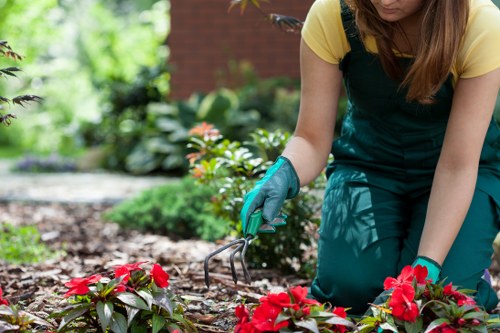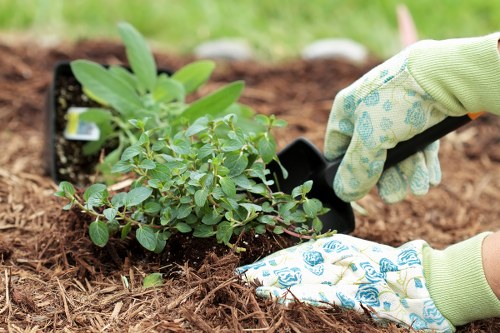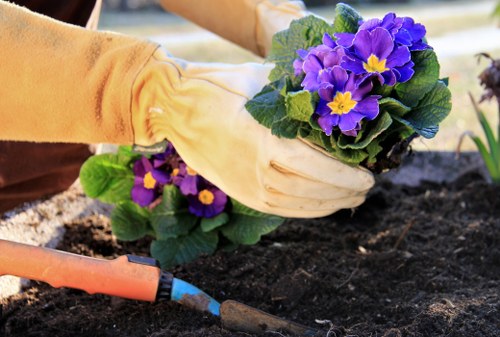Landscape Gardening in Gardening Services

Landscape gardening is a pivotal aspect of professional gardening services, transforming ordinary outdoor spaces into breathtaking environments. Whether residential or commercial, an expertly designed landscape fosters aesthetic beauty, functionality, and sustainability. In this comprehensive guide, we delve into the essential components, benefits, and best practices of landscape gardening, ensuring your outdoor spaces flourish.
Understanding landscape gardening begins with recognizing its multifaceted nature. It encompasses the planning, design, and maintenance of outdoor areas, integrating elements like plants, structures, water features, and lighting. A well-executed landscape design not only enhances curb appeal but also contributes to the overall value and usability of the property.
One of the primary goals of landscape gardening is to create a harmonious balance between nature and human-made structures. This involves careful selection of flora that complements the architectural style of the property and thrives in the local climate. Additionally, thoughtful placement of pathways, patios, and seating areas encourages relaxation and social interaction, making the outdoor space a natural extension of the indoors.

The Importance of Professional Landscape Gardening Services
Professional landscape gardening services offer expertise that goes beyond mere planting. These services provide a strategic approach to outdoor space management, ensuring that every element serves a purpose and contributes to the overall vision. From initial consultation to ongoing maintenance, professionals guide homeowners through the process, addressing challenges such as soil quality, irrigation, and pest control.
Moreover, landscapers possess an in-depth knowledge of plant species, enabling them to select plants that are not only visually appealing but also resilient and low-maintenance. This expertise is crucial in creating sustainable landscapes that require minimal intervention while providing maximum visual and environmental benefits.
Incorporating professional services also means access to advanced tools and technologies. Modern landscape design often utilizes software for 3D modeling, allowing clients to visualize the final outcome before implementation. This collaborative approach ensures that the end result aligns with the client’s vision and functional needs.

Key Elements of Landscape Gardening
Plant Selection and Arrangement
The foundation of any successful landscape garden lies in the careful selection and arrangement of plants. This involves choosing a variety of plants that offer different textures, colors, and heights, creating a layered and dynamic visual effect. Consideration of seasonal changes ensures that the garden remains vibrant throughout the year, with plants blooming at different times to provide continuous interest.
- perennial plants for year-round greenery
- annuals for seasonal color bursts
- succulents for drought-resistant zones
- ornamental grasses for movement and texture
Proper arrangement also takes into account the growth patterns of plants, ensuring they have adequate space to thrive without overcrowding. This not only enhances the aesthetic appeal but also promotes healthy growth, reducing the risk of disease and pest infestations.
Hardscaping Features
Hardscaping refers to the non-plant elements of a landscape, such as pathways, patios, retaining walls, and water features. These structures provide functionality and structure to the garden, defining spaces and facilitating movement. For instance, a well-designed patio offers a perfect spot for outdoor dining and gatherings, while pathways guide visitors through the garden, highlighting key features along the way.
- Patios and decks for outdoor living
- Walkways and paths for accessibility
- Water features like fountains or ponds for tranquility
- Retaining walls for landscaping slopes
Integrating hardscaping elements with softscaping ensures a cohesive and balanced landscape, where each component complements the other, enhancing both functionality and visual appeal.

Sustainable Practices in Landscape Gardening
Incorporating sustainable practices in landscape gardening is essential for creating environmentally friendly and resilient outdoor spaces. Sustainability not only benefits the planet but also reduces maintenance costs and water usage, contributing to long-term garden health.
Water Conservation Techniques
Efficient water management is a cornerstone of sustainable landscape gardening. Techniques such as drip irrigation, rainwater harvesting, and the use of native plants that require less water are pivotal in minimizing water wastage. Mulching is another effective method, as it retains soil moisture, reduces evaporation, and suppresses weed growth.
- Drip irrigation systems for targeted watering
- Rain barrels to collect and store rainwater
- Native and drought-resistant plants to promote sustainability
- Organic mulches for soil health
Soil Health and Composting
Healthy soil is the foundation of a thriving landscape garden. Implementing practices like composting enriches the soil with essential nutrients, improving its structure and fertility. Additionally, practices such as crop rotation and cover cropping prevent soil depletion and reduce erosion, maintaining the garden’s productivity over time.
Integrated Pest Management
Minimizing the use of chemical pesticides through integrated pest management (IPM) ensures a healthier ecosystem. IPM involves monitoring pest populations, encouraging beneficial insects, and using biological controls to manage pests effectively. This approach not only protects plants but also preserves the balance of the garden’s ecosystem.

Seasonal Landscape Gardening Tips
Spring
Spring is the ideal time for planting new shrubs and perennials, as well as preparing the soil for the growing season. Regular pruning and fertilizing promote healthy growth, while early weed control prevents invasive species from taking hold.
- Planting spring-blooming flowers
- Pruning shrubs and trees
- Applying organic fertilizers
Summer
During summer, focus on maintaining consistent watering schedules and providing shade for delicate plants. Mulching helps retain moisture, and regular mowing keeps lawns healthy and attractive.
Autumn
Autumn is the time for harvesting late-season vegetables, planting bulbs for spring blooms, and preparing the garden for winter. Leaf cleanup and soil aeration are essential to prevent fungal diseases and promote soil health.
- Planting fall-blooming plants
- Leaf removal and composting
- Soil aeration and mulching
Winter
Winter gardening focuses on protecting plants from frost and snow. Implementing protective covers and planning for the next growing season can ensure a smooth transition into spring.
Choosing the Right Plants for Your Landscape
Selecting appropriate plants is crucial for creating a vibrant and sustainable landscape garden. Factors such as climate, soil type, sunlight, and water availability must be considered to ensure plant health and longevity.
Understanding Local Climate
Plants that are well-suited to the local climate are more likely to thrive with minimal intervention. Understanding the hardiness zone, temperature ranges, and rainfall patterns helps in selecting species that are resilient and require less maintenance.
- Consulting local climate data
- Choosing native species
- Considering microclimates within the garden
Soil Testing and Preparation
Conducting a soil test provides valuable information about pH levels, nutrient content, and soil composition. Based on the results, amendments such as compost, lime, or sulfur can be added to create an optimal growing environment for plants.
Sunlight and Shade Considerations
Understanding the sunlight patterns in your garden helps in positioning plants appropriately. Full-sun plants require at least six hours of direct sunlight, while shade-tolerant varieties thrive with minimal light.
- Mapping sunlight exposure areas
- Grouping plants based on light requirements
- Incorporating shade structures as needed
Maintenance Practices for a Thriving Landscape
Regular maintenance is essential to preserve the beauty and health of a landscape garden. Effective maintenance practices encompass a range of activities, from pruning and weeding to pest control and fertilizing.
Pruning and Trimming
Pruning helps in shaping plants, removing dead or diseased branches, and promoting healthy growth. Regular trimming ensures that plants maintain their desired form and do not become overgrown.
Watering and Irrigation
Consistent and appropriate watering is vital for plant health. Implementing an efficient irrigation system ensures that plants receive the right amount of water without wastage. Adjusting watering schedules based on seasonal changes helps in conserving water and supporting plant needs.
- Installing automatic irrigation systems
- Monitoring soil moisture levels
- Adjusting watering times during different seasons
Weed Control
Weeds compete with desirable plants for nutrients, water, and sunlight. Effective weed control involves regular removal, mulching, and using ground covers to suppress weed growth naturally.
Pest and Disease Management
Identifying and addressing pest issues early prevents widespread infestations. Utilizing organic pest control methods and promoting beneficial insects can help maintain a balanced garden ecosystem.
Enhancing Your Garden with Decorative Elements
Decorative elements add personality and charm to a landscape garden, making it more inviting and enjoyable. From sculptures to lighting, these features can transform the ambiance and functionality of outdoor spaces.
Outdoor Lighting
Outdoor lighting not only extends the usability of your garden into the evening hours but also highlights key features and ensures safety. Options include pathway lights, spotlights for focal points, and ambient lighting for a warm atmosphere.
- Solar-powered garden lights
- String lights for cozy settings
- LED spotlights for accentuation
Water Features
Incorporating water features such as fountains, ponds, or waterfalls adds a soothing element to the garden. The sound of flowing water enhances relaxation and attracts wildlife, enriching the garden’s ecosystem.
Garden Art and Sculptures
Artistic elements like sculptures, mosaics, and decorative stones infuse creativity and individuality into the landscape. These pieces can serve as focal points or complements to the natural surroundings.
Seating and Outdoor Furniture
Comfortable seating areas encourage relaxation and social interaction. Choosing weather-resistant furniture ensures durability and longevity, allowing you to enjoy your garden for years to come.
Benefits of a Well-Designed Landscape Garden
A thoughtfully designed landscape garden offers numerous benefits, enhancing both the environment and the quality of life of its inhabitants.
Aesthetic Appeal
A beautiful landscape creates a visually pleasing environment, increasing the property’s curb appeal and making outdoor spaces more inviting.
Environmental Benefits
Landscape gardens contribute to environmental sustainability by promoting biodiversity, improving air quality, and managing stormwater runoff. The presence of plants supports local wildlife and creates habitats for various species.
Health and Well-being
Spending time in a well-maintained garden has been shown to reduce stress, promote physical activity, and enhance mental well-being. Gardens provide a peaceful retreat from the hustle and bustle of daily life.
Economic Advantages
Investing in landscape gardening can increase property values and reduce energy costs. Strategic placement of trees and shrubs can provide natural shade, lowering cooling expenses in the summer.
- Increased property value
- Energy cost savings
- Enhanced marketability of the property
Sustainability and Conservation
Implementing sustainable gardening practices conserves natural resources, reduces waste, and minimizes the garden’s carbon footprint, contributing to broader environmental conservation efforts.
Trends in Landscape Gardening
Landscape gardening continually evolves, incorporating new trends and innovations to meet the changing needs and preferences of gardeners.
Native and Drought-Resistant Plants
There is a growing emphasis on using native and drought-resistant plants to create sustainable and low-maintenance gardens. These plants are well-adapted to local conditions, requiring less water and care.
Edible Landscaping
Combining aesthetics with functionality, edible landscaping integrates fruit trees, vegetable beds, and herb gardens into the overall landscape design. This trend promotes self-sufficiency and provides fresh produce right from the garden.
Vertical Gardens
Vertical gardening maximizes space by growing plants on walls or vertical structures. This is especially beneficial in urban settings where space is limited.
- Green walls for urban spaces
- Hanging planters for creative displays
- Trellises and vertical structures for climbing plants
Sustainable Materials and Practices
Utilizing sustainable materials such as recycled stone, reclaimed wood, and eco-friendly composites is becoming increasingly popular. Additionally, practices like composting and rainwater harvesting are integral to modern sustainable gardening.
Smart Gardening Technology
The integration of technology in landscape gardening is on the rise. Smart irrigation systems, automated lighting, and garden management apps enhance the efficiency and ease of garden maintenance.
Conclusion
Landscape gardening stands as a testament to the harmonious blend of nature and design. By leveraging professional gardening services, incorporating sustainable practices, and staying abreast of the latest trends, you can create a landscape that is not only beautiful but also functional and environmentally responsible. Whether you seek a tranquil retreat, a vibrant garden, or a blend of both, landscape gardening offers endless possibilities to transform your outdoor spaces into stunning masterpieces.
Ready to elevate your garden to the next level? Contact us today to explore how our expert landscape gardening services can bring your vision to life. Book your service now and embark on a journey to a more beautiful and sustainable outdoor sanctuary.